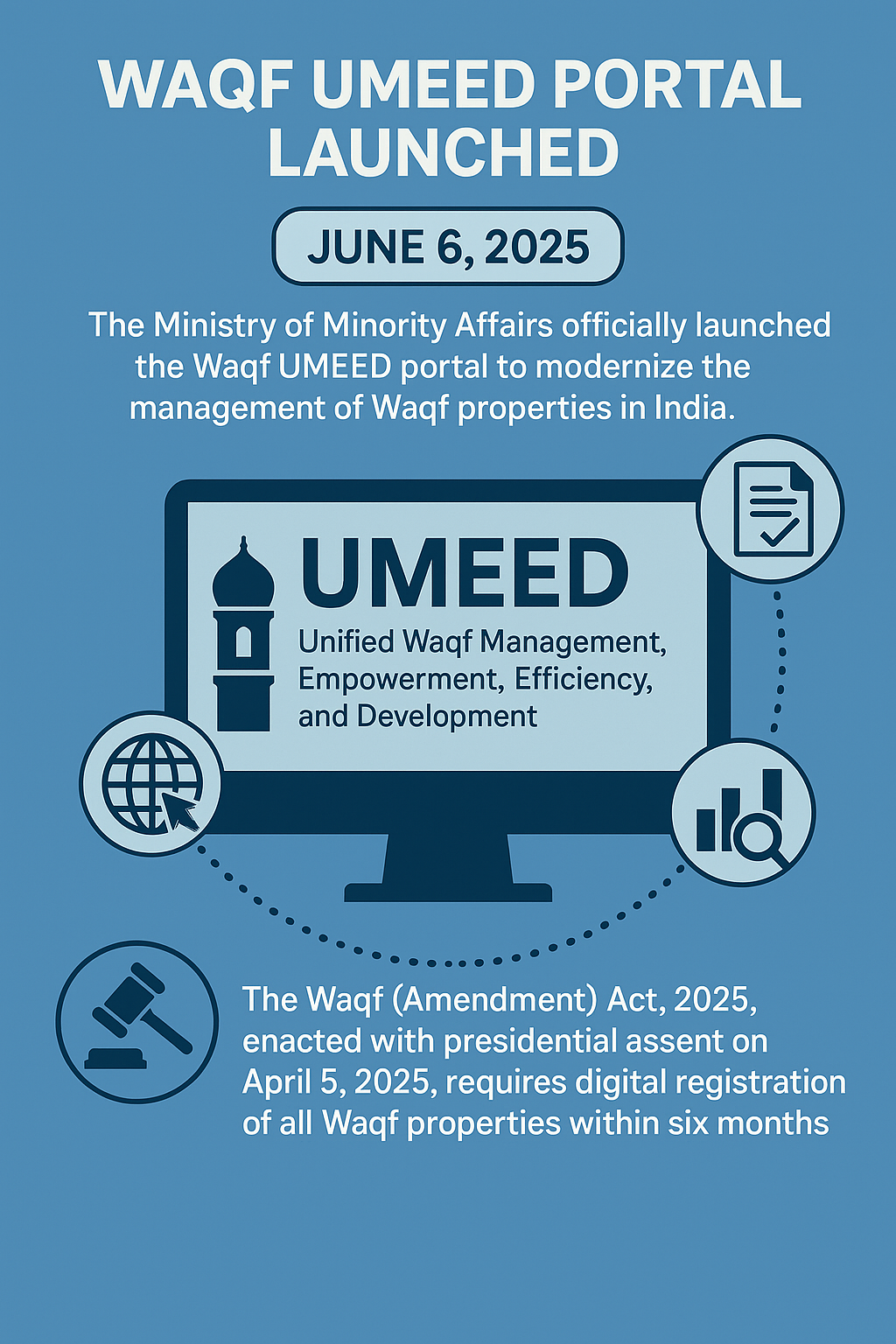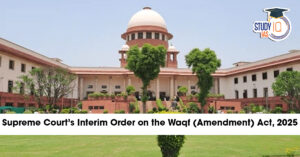Table of Contents
The Waqf UMEED portal was officially launched on June 6, 2025, by the Ministry of Minority Affairs as a significant step toward modernizing the management of Waqf properties in India. This digital platform, known as Unified Waqf Management, Empowerment, Efficiency, and Development (UMEED), aims to centralize and simplify the registration, verification, and monitoring of Waqf assets across the country.
Waqf UMEED Portal
The Waqf UMEED portal’s rollout follows the enactment of the Waqf (Amendment) Act, 2025, which received presidential assent on April 5, 2025. This amended legislation mandates the digital registration of all Waqf properties within six months of the portal’s launch, thereby reinforcing legal accountability and administrative oversight.

What is Waqf?
Waqf is a term that denotes a permanent charitable endowment recognized by Islamic law. In this context, an individual dedicates assets, which can be either movable or immovable, such as land, buildings, or monetary funds, to fulfill objectives related to religion, education, or public welfare. Once a Waqf is established, the principal asset becomes inalienable, meaning it cannot be sold, gifted, or passed down through inheritance. Only the income generated from these assets can be utilized for the intended charitable purposes.

Waqf (Amendment) Act of 2025
The Waqf (Amendment) Act of 2025 introduced significant reforms to enhance the management and oversight of Waqf properties. One of the key changes is the establishment of an appeals mechanism, which allows decisions made by Waqf tribunals to be contested in High Courts within a 90-day period. This provision ensures that there is judicial oversight and offers an avenue for parties feeling aggrieved by a tribunal’s decision to seek further redress.
Another important reform is the mandatory digital registration of Waqf properties. Under this amendment, all existing Waqf properties throughout India are required to be uploaded onto the Unified Waqf Management, Empowerment, Efficiency, and Development (UMEED) portal within six months from the commencement of the Act. This transition from traditional physical record-keeping to a centralized digital database is aimed at improving efficiency and transparency.
Additionally, the amendment introduces a mechanism for flagging disputes related to unregistered assets. Properties that are not registered on the UMEED portal by the specified deadline will automatically be classified as “disputed.” Such cases will then be directed to the relevant Waqf tribunal to expedite adjudication, thereby mitigating the risk of silent encroachments and facilitating quicker dispute resolution.
Finally, there is a strengthened oversight at the state level. Each State Waqf Board is now required to appoint a senior nodal officer with a minimum rank of Joint Secretary and establish a dedicated support unit. These measures are intended to ensure that there is proper monitoring of portal uploads, audits, account management, and compliance with Waqf regulations. Overall, these reforms aim to enhance transparency and accountability within the Waqf sector, thereby benefiting vulnerable beneficiaries and the broader community.
Objectives and Vision of the Waqf UMEED Portal
The UMEED Portal, which is short for Unified Waqf Management, Empowerment, Efficiency and Development, has been developed to transform Waqf property administration by moving from disparate, paper-based registries to a unified online system that covers the entire country.
Its core mission is to establish a fully transparent digital registry, enabling beneficiarie,s especially underprivileged groups like women and children, to securely view their rights and verify how Waqf assets are being utilised in real time.
By automatically identifying unregistered or disputed properties and routing them through formal adjudication channels, the platform aims to resolve decades-old litigations, deter encroachments, and reinforce both legal certainty and administrative accountability.
This paradigm shift invites active public participation at every stage from property listing to lease monitoring ensuring that community-owned endowments serve their intended charitable purposes without delay or misuse.
Core Features of the UMEED Platform
- Creation of a geotagged digital inventory covering every Waqf property, with precise location data for accurate mapping and audit trails
- A dedicated online grievance redressal system to lodge complaints and ensure swift, transparent responses
- Real-time tracking of leasing arrangements and usage metrics to prevent unauthorised occupation or diversion of assets
- Integration with GIS mapping and other e-Governance tools for spatial analysis, policy insights, and streamlined administrative workflows
- Public access to authenticated records, summary reports, and performance dashboards to foster community oversight and trust
- Digitisation of property records with geotagging and unique IDs
- Streamlined registration through a three-tier verification system (Mutawalli → District Officer → Waqf Board)
- Enhanced transparency by making basic property details publicly accessible
- Efficient dispute resolution, with unregistered properties identified and referred to the Waqf Tribunals
This initiative reflects a broader effort to establish clarity, inclusivity, and legal rigour in the governance of religious endowments, aligning with the structural reforms introduced under the 2025 amendment.
Key Features of the UMEED Portal
The UMEED portal delivers a suite of transformative capabilities aimed at digitising every aspect of Waqf property registration and management across India. Its feature set is built to ensure timeliness, accuracy, legal clarity, and user empowerment.
Mandatory, Time-bound Registration
Within six months of the portal’s launch, all existing Waqf properties must be formally enrolled on the platform. This strict deadline enforces compliance and provides a clear roadmap for State Waqf Boards and mutawallis to complete registrations, with a possible short extension only in case of technical impediments.
Geotagging and Digital Mapping
Each property entry requires precise measurements of length, width, boundary coordinates and geolocation tags. This digital footprint not only enhances the integrity of land records but also integrates seamlessly with GIS tools for real-time monitoring and spatial analysis.
Dispute Classification for Non-registration
Properties that remain absent from the system after the deadline automatically carry a “disputed” status. Such cases are escalated to the Waqf Tribunal, ensuring that unresolved registrations trigger formal adjudication rather than lingering in bureaucratic limbo.
User Support and Legal Awareness
To help beneficiaries navigate their rights and obligations under the amended law, the portal features dedicated user support services. This includes helpdesks, FAQs, and legal guides that demystify registration procedures and outline dispute-resolution pathways.
Conclusion
The implementation strategy for the UMEED portal involves a comprehensive, multi-layered approach initiated by the Ministry of Minority Affairs, led by Secretary Dr. Chandra Shekhar Kumar. This includes regional workshops for State Waqf Boards in states like Maharashtra and Bihar to clarify statutory requirements and technical workflows, ensuring compliance with a six-month registration timeline.
A secure cloud-based backend supports real-time data uploads and GIS integration, complemented by a 24×7 toll-free helpline, online tutorials, and in-platform support for users. An inter-ministerial task force and regional nodal officers monitor progress through field visits and feedback collection, allowing for iterative policy refinements based on stakeholder input. This strategy aims to foster trust and establish a transparent framework for managing Waqf properties effectively.

 Reserved vs General Quota: Supreme Court...
Reserved vs General Quota: Supreme Court...
 Supreme Court’s Interim Order on the W...
Supreme Court’s Interim Order on the W...



















